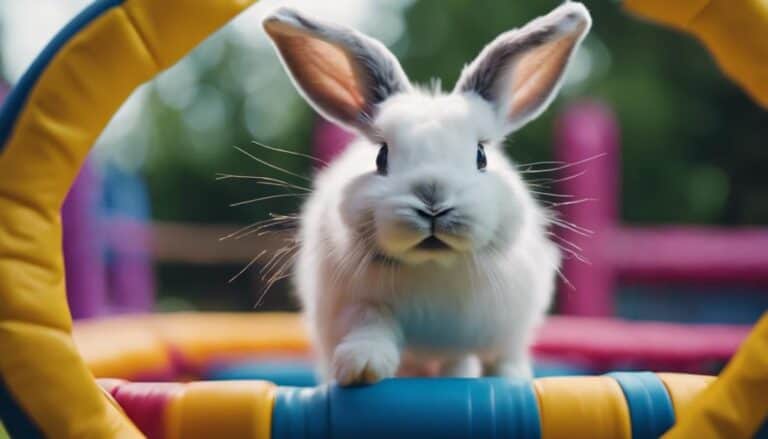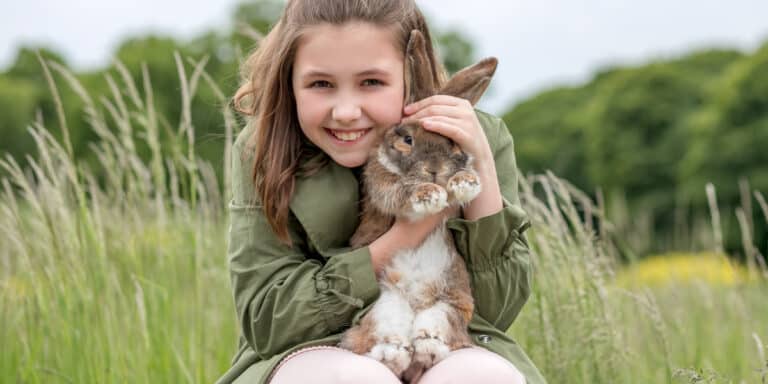Bunnies binky to show joy and playfulness. Their digging habits stem from wild instincts and help maintain health. Rabbit flopping indicates relaxation and trust. Different vocalizations convey various emotions. Territorial chinning establishes dominance. Nipping can indicate seeking attention. Redirecting biting behavior requires supervision and patience. Understanding these behaviors allows you to connect better with your bunny.
Contents
- 1 Key Takeaways
- 2 Bunny Binkying Behavior
- 3 Digging Habits of Bunnies
- 4 Understanding Rabbit Flopping Actions
- 5 Bunny Vocalizations and Their Meanings
- 6 Territorial Chinning in Rabbits
- 7 Nudging and Licking Behaviors
- 8 Handling Rabbit Nipping and Biting
- 9 How Can Understanding Common Bunny Behaviors and Habits Contribute to a Vibrant Rabbit Lifestyle?
- 10 Conclusion
Key Takeaways
- Binkying shows joy and playfulness.
- Digging is instinctive for shelter and health.
- Flopping indicates relaxation and trust.
- Vocalizations express emotions and warnings.
- Territorial chinning establishes dominance and communication.
Bunny Binkying Behavior
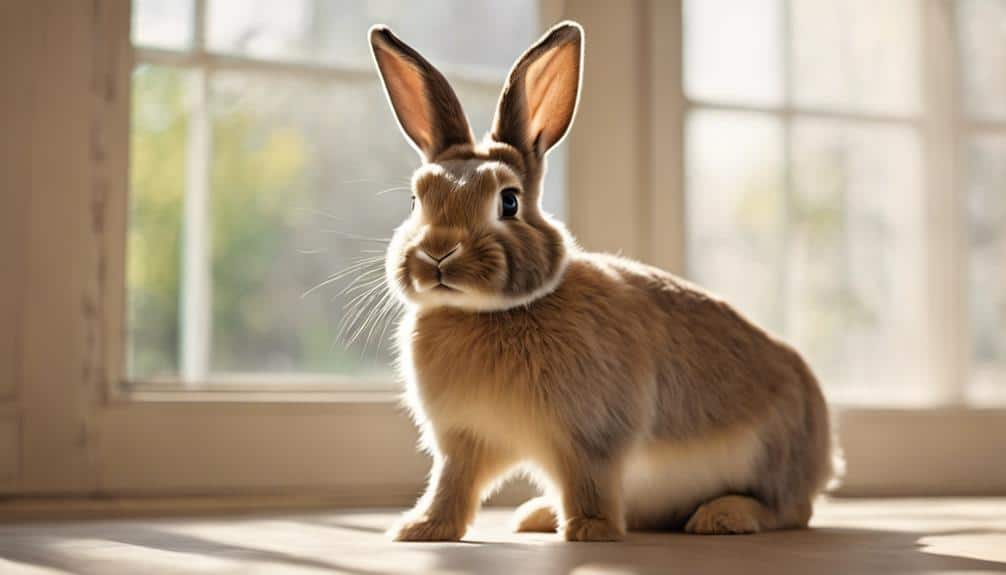
When observing rabbits, one can't help but be captivated by the delightful and joyful behavior known as bunny binkying. This energetic movement, where rabbits leap into the air and twist their bodies, is a clear sign of happiness and contentment. As you watch your bunny binkying, pay attention to their legs and body language. The way they kick their legs out and twist mid-air displays their excitement and joy in that moment.
Bunny binkying is a natural behavior that rabbits exhibit when they're feeling playful or excited. It's common to see rabbits binkying during their playtime, especially when they're enjoying themselves and exploring their surroundings. Understanding this behavior can help you connect with your rabbit on a deeper level and guarantee their happiness and well-being.
Digging Habits of Bunnies
Have you ever noticed the instinctive digging habits of bunnies and wondered why they engage in this behavior? Bunnies have a natural inclination to dig, a behavior rooted in their wild instincts. In the wild, bunnies dig to create burrows for shelter, nests for their young, and to find food. This behavior is retained by domestic bunnies, who may exhibit digging behaviors in carpets, furniture, or bedding.
When bunnies dig, they primarily use their strong back legs to excavate the ground. This digging behavior is essential for bunnies to maintain their nails trimmed and teeth healthy. Additionally, bunnies have scent glands on their chin and paws, so digging also helps them mark their territory with their scent.
To manage this behavior in a domestic setting, providing a designated digging area with suitable substrate can help redirect their natural instincts. By monitoring and encouraging appropriate digging habits, you can prevent damage to household items and safeguard your bunny's well-being and enrichment.
Understanding Rabbit Flopping Actions
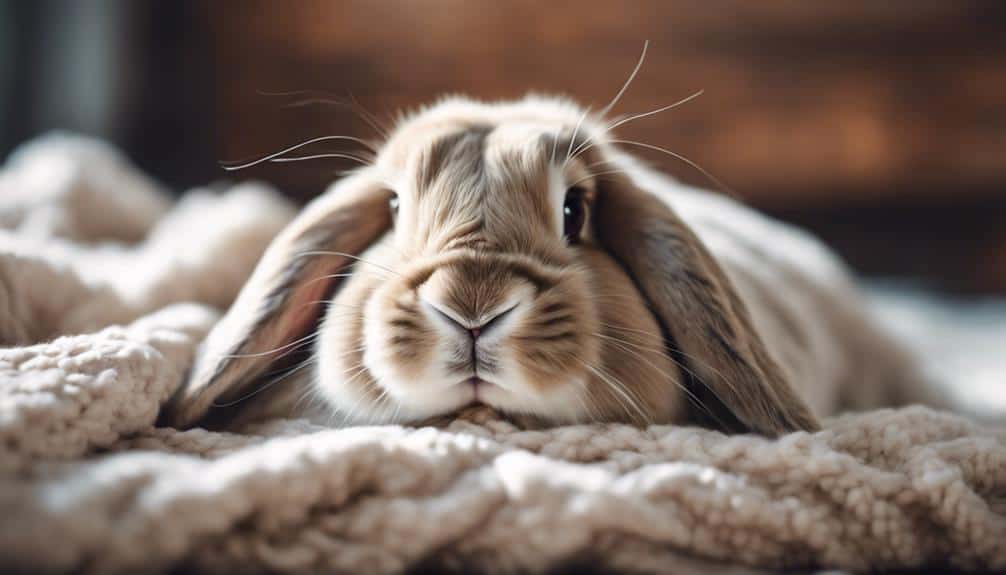
Rabbit flopping behavior, often observed in domestic rabbits, signifies a state of relaxation and contentment. When your pet rabbit flops onto its side, it's displaying a deep level of trust and comfort in its environment. This action allows rabbits to stretch out fully, releasing tension in their muscles and indicating a sense of security.
By flopping, rabbits show that they feel safe, happy, and at ease in their surroundings, creating a peaceful atmosphere. Not only does flopping serve as a way for rabbits to relax, but it also helps them regulate their body temperature, especially during warmer periods.
Observing your rabbit flop is a heartwarming sight that demonstrates the bond and trust between you and your furry companion. Remember, when your rabbit flops, it's a positive sign that they're content and at peace in your care.
Bunny Vocalizations and Their Meanings
Bunny vocalizations provide valuable insights into the emotional state and needs of these furry companions. When your rabbit grunts, it may be feeling angry or stressed, while honking or buzzing noises often indicate excitement. If you hear screams, your rabbit might be in severe pain, whereas teeth grinding could mean they're either enjoying a moment or experiencing discomfort. Additionally, thumping is a warning signal to other rabbits that there may be danger nearby.
Understanding these vocal cues is essential for interpreting your bunny's emotions accurately. For instance, a soft nudge accompanied by teeth grinding may signal contentment during a petting session. On the other hand, loud grunts could indicate that your rabbit is feeling threatened or upset. By paying attention to these sounds and observing your bunny's body language, you can better cater to their needs and make sure they feel safe and comfortable in their environment.
Territorial Chinning in Rabbits
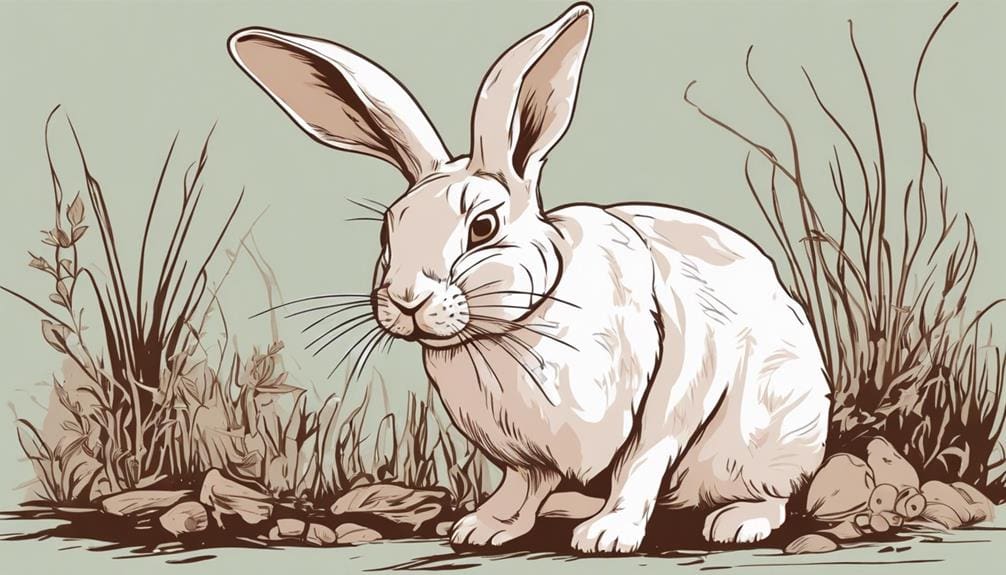
When rabbits engage in territorial chinning, they're claiming ownership and defining their space by leaving scent marks with their chin glands.
This behavior isn't just about marking territory; it also serves as a way for rabbits to assert dominance and communicate with others through scent cues.
Chinning as Marking Behavior
Marking their territory with a subtle yet impactful gesture, rabbits engage in territorial chinning by rubbing their chin on various objects and individuals to assert dominance and communicate ownership through scent markers. This behavior is driven by scent glands located under their chin, releasing pheromones that serve as territorial markers.
By chinning objects, animals, or even humans, rabbits establish boundaries and convey messages to other rabbits about their territorial rights. Understanding territorial chinning offers valuable insights into rabbit social dynamics and the hierarchy within their groups.
Observing this behavior can help you comprehend how rabbits communicate and establish dominance, allowing you to better cater to their social and territorial needs.
Sign of Territorial Dominance
Chinning behavior in rabbits serves as a significant indicator of territorial dominance within their social groups. When rabbits chin objects or individuals, they're marking them with scent from the glands under their chin. These scent markings contain pheromones that communicate messages to other rabbits about their ownership and dominance in the area.
By engaging in territorial chinning, rabbits establish boundaries and assert their control over their environment. This behavior isn't only essential for communication among rabbits but also for maintaining social hierarchies within the group.
As a rabbit owner, recognizing and understanding territorial chinning can help you respect your pet's need for space and acknowledge their instinctual behaviors related to marking territory.
Communication Through Scent
Upon chinning objects or individuals, rabbits assert their ownership and establish territorial boundaries through the unique scent secreted from their chin glands. This behavior, known as territorial chinning, is a common way for rabbits to communicate with others of their kind.
The scent glands located on their chin release a distinct odor that helps rabbits mark their territory and assert dominance. When a rabbit rubs its chin on objects or even people, it's claiming them as its own. Both male and female rabbits exhibit this behavior to show ownership and establish boundaries within their environment.
Understanding this form of communication through scent is important in deciphering the complex social interactions and hierarchies among rabbits.
Nudging and Licking Behaviors
When observing rabbits, one can notice that their nudging and licking behaviors serve as essential forms of communication and social interaction.
- Nudging for Attention: Rabbits often nudge their owners gently with their noses to seek attention or show affection. This behavior is their way of communicating their needs or desires, indicating a desire for interaction or petting.
- Licking for Bonding: Licking is a grooming behavior in rabbits that serves multiple purposes. Apart from keeping their fur clean, licking is a way for rabbits to bond with each other and show affection. When a rabbit licks you, it's a sign of trust and fondness.
- Natural Expressions of Emotions: Both nudging and licking are natural behaviors in rabbits that reflect their emotions and social interactions. Understanding these behaviors can help you build a stronger bond with your rabbit and cater to their needs effectively.
Handling Rabbit Nipping and Biting
When dealing with rabbit nipping and biting, it's crucial to grasp the reasons behind these behaviors.
Nipping prevention tips can assist you in managing these interactions effectively.
Redirecting biting behavior through suitable toys and training is vital to nurturing a positive relationship with your bunny.
Nipping Prevention Tips
To prevent nipping behavior in rabbits, establish clear boundaries and provide positive reinforcement to redirect their communication efforts effectively. Here are three tips to help you manage and prevent nipping behavior in your bunny:
- Positive Reinforcement: Reward good behavior with treats and praise to encourage positive interactions.
- Chew Toys: Provide a variety of safe chew toys to satisfy their natural urge to nibble and prevent excessive nipping.
- Social Interaction: Spend quality time with your rabbit, engaging in play and petting sessions to make sure they feel socially stimulated and less likely to nip out of frustration or boredom.
Understanding Bunny Behavior
Understanding bunny behavior, particularly in relation to handling rabbit nipping and biting, is vital for fostering a harmonious relationship with your furry companion.
Rabbit nipping is often a gentle way of communication, used to seek attention or show affection. On the other hand, rabbit biting can stem from fear, discomfort, or the need to establish dominance within their social structure.
By implementing proper handling techniques and training methods, you can effectively reduce and redirect these nipping and biting behaviors. It's essential to comprehend the underlying reasons behind your rabbit's actions to build a trusting and respectful bond.
Consistent use of positive reinforcement strategies can be instrumental in discouraging unwanted nipping and biting behaviors in rabbits.
Redirecting Biting Behavior
Redirecting a rabbit's biting behavior involves providing appropriate chew toys to satisfy their natural chewing instincts. When handling rabbit nipping and biting, consider the following:
- Supervision: Stay attentive during interactions to identify triggers for nipping or biting behavior.
- Positive Reinforcement: Utilize training techniques that reward good behavior to discourage biting tendencies in rabbits.
- Consistency and Patience: Establish a consistent training routine and be patient in redirecting biting behavior for effective results.
How Can Understanding Common Bunny Behaviors and Habits Contribute to a Vibrant Rabbit Lifestyle?
Understanding common bunny behaviors and habits is crucial for creating a vibrant rabbit lifestyle. By familiarizing ourselves with their natural tendencies, such as digging, chewing, and socializing, we can provide appropriate outlets for these behaviors. This knowledge helps us tailor their environment, diet, and playtime, ensuring their physical and mental well-being. Unveiling these vibrant rabbit lifestyle secrets enables us to build a fulfilling and happy life for our furry companions.
Conclusion
As you observe your furry friend's binkying, digging, flopping, vocalizations, chinning, nudging, and licking behaviors, you'll begin to understand the intricate world of bunny habits.
Like a symphony of quirks and gestures, your rabbit communicates its unique personality through these actions.
Embrace the joy of decoding their language and building a deeper bond with your fluffy companion.
The world of bunnies is a fascinating one, full of surprises and delights waiting to be discovered.

